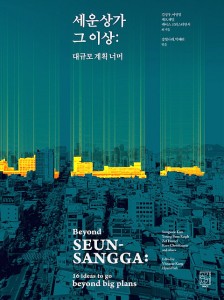Beyond Seun-Sangga: 16 Ideas to go beyond big plans, pp. 124-143
Hyeri Park and Vitnarae Kang (eds.)
Space Books | Seoul | 2015 | ISBN 979-11-87071-00-6
The Seun Arcade area is one of the remaining traditional industrial clusters in downtown Seoul. Most of these clusters date back to the early modern or even pre-modern times and were established along the major roads of Jongno, Euljiro and the former Cheonggye Expressway. Due to the continued transformation of downtown Seoul over the past few decades, many of these original clusters have already disappeared. Their transformation has often been legitimised as a seemingly unavoidable improvement of what were seen as economically underdeveloped or underused, socially decayed, unsafe or even dangerous urban areas. These places were at the same time portrayed as the unsightly legacy of South Korea’s developmentalist past, which should be eradicated and replaced by a new efforts in urban development.
Over many years of on-going urban redevelopment, these traditional industrial cluster have rarely been recognised as important social and cultural assets. Traditional industrial clusters are not only productive, but also dense social networks, which are largely based on thick interpersonal bonds of trust, a strong sense of solidarity among the member, and a shared communal culture. At the same time, the traditional industrial clusters also form distinct cultural forms, which express a particular history of the city, as well as of citizens and their everyday life.
Wangsimni is perhaps not the most representative of many traditional industrial clusters in Seoul. Nevertheless, it had a rather long history of small-sized industrial site. Small workshops, mostly for the metal industry, used to be integrated with larger productive and social networks. Industry has always been deeply intertwined with the everyday life of the area. In this sense, the transformation of Wangsimni offers valuable lessons about traditional industrial clusters, unfortunately now lost, along with its associated communal culture and everyday life, as a results of large-scale urban redevelopment.
Source: Vmspace.com

